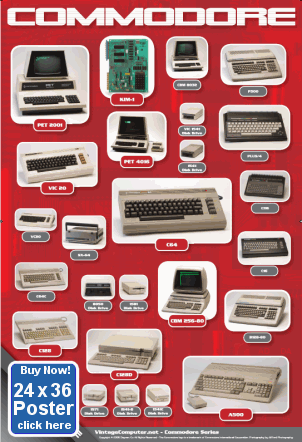 VC Blog | Contact
VC Blog | ContactSimon - A Desktop Computer in 1950
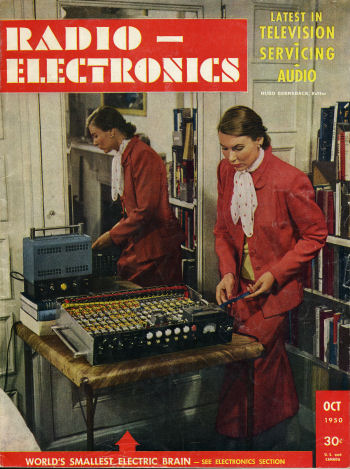
Radio-Electronics October 1950 Front Cover - World's Smallest Electronic Brain. Berkely and Jensen's Simon is considered by many to be the first "desktop" computer. Closeup image of the Simon desktop computer.
Simon is considered by many, and until someone proves otherwise, to be the first analog/mechanical desktop computer. Here is a link to a web page that lists a timeline containing the earliest desktop or personal computers. To follow is a transcript of the October 1950 Radio-Electronics cover story. Enjoy!
World's Smallest Electric Brain
By EDMUND C. BERKELEY* and ROBERT A. JENSEN
(* Edmund C. Berkley is the author of Giant Brains)
"..ON THE COVER of this issue of RADIO-ELECTRONICS is a picture of the smallest existing, complete electric brain. This midget electric brain is named Simon, in honor of Simple Simon of Mother Goose fame. He can be called electric or mechanical for he uses relays; but not electronic, for he does not use a single electron tube. Nevertheless he illustrates in solid hardware the principles of all the giant artificial brains, electronic, electric, or mechanical. He is perhaps the only electric brain small enough to be understood completely by one man.
(* Edmund C. Berkley is the author of Giant Brains)
Simon is about 24 inches long, 15 inches wide, and 6 inches high. He weighs (not counting his power supply) about 39 pounds. He runs on 24 volts d.c., drawing at most about 5 amperes. And in number mentality, Simon at present compares with a child of two years, for he knows only four numbers, 0, 1, 2, and 3.
Simon is slow. He performs each operation in about 2/3 second-unlike the electronic brain finished in 1949 called Binac, which adds at the rate of 3,500 additions per second. And yet Simon is a true mechanical brain, for he has the two essential properties that define a mechanical brain: he can transfer information automatically from any one of his 16 registers to any other, and he can perform endlessly long sequences of reasoning operations.
What is the purpose of this little idiot of an electric brain-or should he be looked on rather as a baby, with capacity to grow? Why was it worth while to build him?
The purpose of Simon
An editorial entitled "Simple Simon" in the Wall Street Journal for May 22, 1950, expressed in part the purpose of Simon: it said, "The world may admire a genius but it loves a moron." The same may perhaps be true of the crew of men who want to know how electric brains work, what they are all about, and how to construct them. It may be rather easier to understand the working of a little moron of an electric brain, that a student can easily feel superior to, than it is to understand the working of a giant electric brain, that a student can easily feel inferior to.Simon was designed and built to exhibit in simple understandable form the essential principles of any artificial brain. He will be useful in lecturing, educating, training, and entertaining- just as a spinning toy gyroscope is both entertaining and instructive. For it is certainly true that the demand for computer-trained electronics engineers, operators, maintenance men, mathematicians, etc., is steadily growing in the new field of automatic computing machinery.
There are now more than a dozen kinds or species of these giant artificial brains. Most are represented by just one example, such as the rather old but still spry-Harvard IBM automatic sequence-controlled calculator, finished in 1944. This machine handles numbers of 23 decimal digits and can remember 72 of them at one time. There are now in use more than 20 machines of the type known as the International Business Machines cardprogrammed calculator, and more than 80 of the type known as the Reeves electronic analogue computer.
Digital and analogue computers
These artificial brains are of two main types: digital and analogue. A digital machine expresses information by the positioning of devices in anyone of a small number of exact positions. For example, a human hand with fingers up or down may express 0, 1, 2, 3, 4, 5; or a counter wheel can stop at anyone of the spots 0 to 9; or a light can be on or off, 2 positions; or a relay may be energized or not energized; or an electron tube may be conducting or not. All these devices are digital.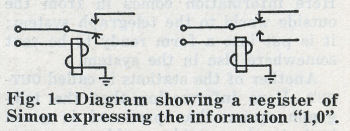
An analogue machine, on the other hand, expresses information as the measurement of a physical quantity, such as distance moved, or amount of rotation, or electric potential, etc. The measurement is analogous to a number in the computation.
But there is no easy way for an analogue machine: (1) to manipulate alphabetic information given in letters; (2) to express random numbers; (3) to express any numbers with an accuracy of more than 5 or 6 decimal digits; (4) to handle problems where the solution requires different decisions and subroutines, depending on what happens in the course of the problem. All these things a digital machine can do easily. Thus a digital machine can do rather more than an analogue machine. In fact it begins to look as if the digital machine of the future has within itself an unlimited capacity to think. This series of articles will deal mainly with digital electric brains.
How an electric: brain works
How does an electric brain work? A good mental picture of the working of an electric brain is an isolated telegraph system, with a number of communicating central stations and a traffic control. The messages that this telegraph system handles are usually pieces of information of standard length, with a standard number of digits.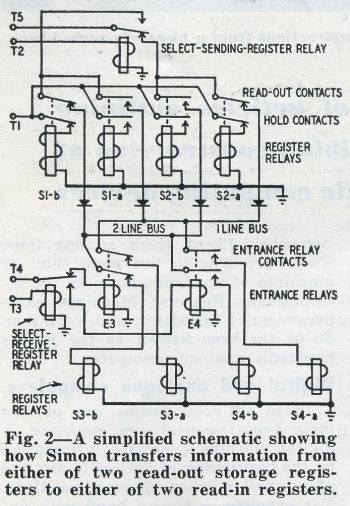
One of the stations is called INPUT. Here information comes in from the outside world to the telegraph system; it is put into a form ready to be sent somewhere else in the system.
Another of the stations is called OUTPUT. Here information that the telegraph system has produced is given back to the outside world. There are a whole flock of stations called STORAGE No.1, STORAGE No.2, STORAGE No.3, and so on. Here information may be stored without changing while waiting for some other part of the system to call for the information and do something more with it.
A very important station with room for several incoming pieces of information is the COMPUTER. This station is combined with a factory, a calculating device that can , accept several pieces of information 'and manufacture new information out of them.
For example, the calculating device may have four receiving points or platforms. On two platforms, the computer takes in two numbers such as 140 and 25. On the third platform the computer takes in an order to subtract, multiply, or find which is bigger, etc. On the fourth platform the computer delivers a result (for example, 115), the result of combining 140 and 25 according to the order to subtract.
To calculate with this telegraph system, we must have some way of organizing traffic through it. That is the duty of the central traffic control. The most automatic way for sending information through the system is:
(1). At anyone time connect just two telegraph stations, such as "Albany" and "Boston";
(2). Specify the direction of traffic, such as "from Albany to Boston."
Then as soon as the proper connections have been completed, send the signal "go," and the information at Albany will be transferred automatically to Boston.
There are two ways to get the central traffic control to function properly. One is to have all the orders ready ahead of time, and tell it to do just as it is told. This is dictatorship. The second way is to have some special wires of the telegraph system run into the central control, and let information from time to time (though not all the time) come from the system into the central control-feedback. The central control then knows what is going on and can direct the following steps. This is democracy. This second technique of course is a honey, even with electric brains, and a good electric brain does compute some-or even most-of its own instructions.
Information
Such then is the mental picture of the working of an electric brain. But just what do we mean by information?For the purposes of an electric brain, information is simply the arrangement of certain physical equipment. For example, a hand with two fingers up and three down is regularly considered to express the number two. Or suppose we take a pair of relays, a left-hand one and a right-hand one. Either one of these relays may be energized (let us report this condition as 1) or not energized (report this condition as 0). The information therefore that this pair of relays can represent is 00, 01, 10, and 11-four possibilities. (Here 10 is not ten, and 11 is not eleven). Let us number these four possible pieces of information 0, 1, 2, 3. Now we have the exact way a register of Simon expresses numbers (see Fig. 1).
Transfer of information
An electrical brain, like an automatic telegraph system, can transfer information automatically from one register to another. How does this take place?Suppose we take some registers of Simon (a little simplified) and see how transfer does take place. Let us take two storage registers Sl and S2 (S for storage) from which we may read out information, and two more storage registers S3 and S4, into which we may read information. Each of these registers has two relays to supply the four possible pieces of information. Suppose we desire to transfer information from register S2 into register S3.
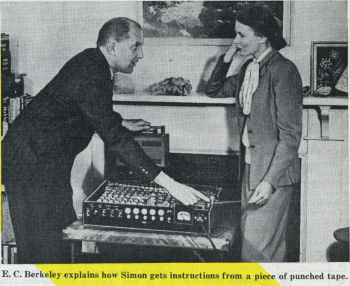
Looking at Fig. 2, we see 12 relays, of which eight are the relays for registers Sl to S4. We also see five terminals, T1 to T5, which energize the relays. The terminals are energized, that is, carry current, in the sequence of their numbers.
Let us consider time 1. At this time the circuit running from T1 to ground passes through both the closed HOLD contracts and the coils of (two out of) four relays Sl-b, Sl-a, S2-b, and S2-a. By a previous operation, the two relays Sl-b and S2-a were energized and are now held up by continuous current from terminal Tl. We see that information "1,0" is stored in register Sl and that information "0,1" is stored in register S2.
Let us pass to time 2, and look for terminal T2. At time 2 we see that the SELECT-SENDING-REGISTER relay is 'energized, and consequently register S2 is selected to send out its information.
Now let us pass to time 3, and look for terminal T3. The SELECT-RECEIVING-REGISTER relay, whose pickup coil is connected to T3, is not in this case energized. As a result, register S3 is selected to receive.
Passing to time 4, we look for terminal T4. As current flows along the wire from T4, the entrance relay for register S3 is energized. We have connected the pickup coils of register S3 to the bus, and therefore -S3 can receive information from the bus.
We have now completed all the preparations needed to transfer information from register S2 to register S3. We now pass to time 5. Pulsing terminal 5, we see that the pulse of current flows as follows:
(1). through the selection circuit that selects the sending register S2;
(2). through the readout contacts of the sending register S2;
(3). through the rectifiers (which prevent back circuits);
(4). through the bus;
(5). through the contacts of the entrance relay belonging to the receiving register S3;
(6). into the coils of the receiving register S3 (naturally and properly, only the right-hand relay S3-a is energized, however); and
(7). to ground.
This then is an illustration of the principle of transferring information from one register to another. The scheme is entirely general: a pattern of information "written" in one register is "copied" in another.
Memory Tube Aids Electronic Brains
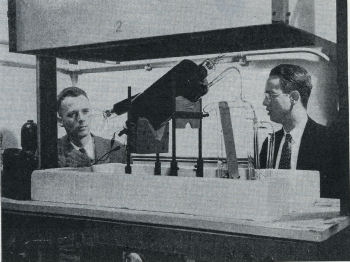
"The tube in the photo is a memory tube for computers which remembers as many as 400 digits. Air in the tube is being removed and it will be "cured" in this over-like apparatus. At left is J.W. Forrester and at right S.H. Dodd of the MIT Servomechanisnms Laboratories, where the new tube was developed." From October 1950 Radio-Electronics.
Items Available

Click Here for an up-to-date listing of items available for trade or sale. If you find an item of interest or you have an item to donate, please contact me.
Classic Computing Items for Sale:
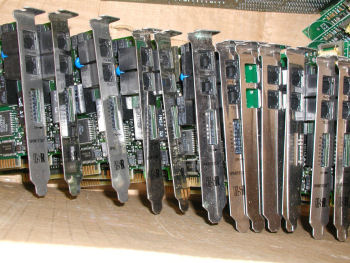
| CBM Commodore B Series Software (B-128 / CBM 700) | ||
| Superscript II Word Processor | $29.99 | |
| Superbase Database Manager | $29.99 | |
| Commodore Advanced Business Systems (CABS) Acccounting Suite: Accounts Payable, Order Entry, Accounts Receivable, General Ledger (4 binders) | $29.99 | |
| More CBM Commodore Items | ||
| Commodore B-128/700 Programmer's Reference Guide - Protecto - Everything you need to know about the B line! | SOLD OUT | |
| B Series Commodore Users Guide - View Image | $39.99 | |
| Commodore Users Guide Series 8000 | $39.99 | |
| Commodore BASIC Users Refence Manual Version 4.0 | SOLD OUT | |
| Commodore CBM Expansion Memory Board 64K Expansion Kit for PET 8032 (NOS) | SOLD OUT | |
| Commodore PET Keyboard (NOS) for 2001 -N, 3000, 4000 Series | SOLD OUT | |
| Other Commodore CBM Power supplies, software, parts, etc. | Contact Me | |
| Tandy Items | ||
| Aeoromp Double Density Controller for TRS 80 Model 1 Expansion Unit (NOS)- details | SOLD OUT | |
| Model III / Model 4 (non-gate array only) RS-232 KITS details | SOLD OUT | |
| Model III / Model 4 (non-gate array only) RS-232 boards only | SOLD OUT | |
| Model III Aerocomp Diskdrive controller | $39.99 (free US Ship) | |
| Looking for Something Else? | ||
| Please check here first with special requests for Commodore, IBM, Tandy, Atari, TI, Apple computers, parts, components, and software. I have systems plus zounds of miscellaneous items for sale or trade. | ||
Computer History at the University of Delaware
Instructor Degnan assisting a student with an IBM 5140 laptop computer programming assignment. Students learn best by using the systems they're studying, just like musical instruments, bicycle repair, or circular saws. And it's a lot more fun, eh?
Past Issues:
On the Work Bench Dec '08 - Feb '09
Check my Vintage Computer Blog to search for older articles, or post your questions.Locating the Bootstrap Loader Morrow DJ/DMA Drive Controller
The Morrow DJ/DMA disk drive controller was one of the most sophisticated drive controllers produced in the early 1980's S-100 systems.
Using Bob Grieb's Z80 ICE v 0.62 I located the bootstrap loader in memory. Here is how I did it.
Compaq Contura 4/25c
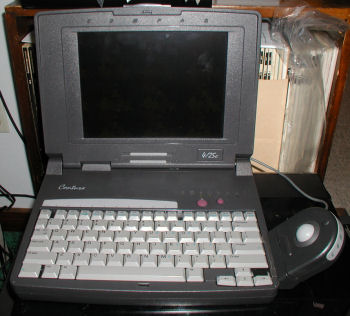
The Compaq Contura 425c. Note that the pointing device for this laptop was a detachable trackball mouse, which allowed for a larger keyboard. There is a spring that is used to clamp the trackball to the side of the keyboard on the side front.
The Compaq Contura 4/25c is a 486 laptop that I used to support when I worked at Zeneca in the early 1990's. The Contura was a lighter-weight Compaq laptop of the early 1990s. I received this computer with Windows 95 installed, but it would have come with Windows 3.1. I tested the modem and it worked. The battery needs to be replaced, it would not hold a charge.
Pictures... read more
Handic CBM BX700 Cartridge Software
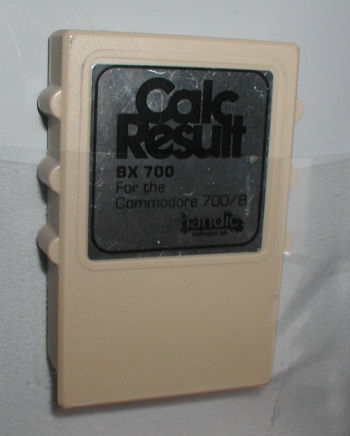
In 1983 the Sweedish company Handic produced software for the CBM BX700 called Calc Result (spreadsheet) and Word Result (word processor). There were also versions of this software made for the C64 model.
Now that I have successfully installed and tested the 8088 co-processor, I thought that I would next try the Handic software supposedly made for the BX700. The "X" indicating the presence of an 8088 co-processor. This is probably a rare software because there were few BX700's sold in Europe, and the software would have seen limited sales as well.
I was able to run both the Calc Result and Word Result software cart/disk programs. I am not sure if the 8088 was required, I only teste... read more
MITS Software Agreement
You get this stuff and then you wonder what you're going to do with it, but I came upon an original copy of the MITS Software Agreement which means I guess that my copies of Altair BASIC are legal? Comments?Lanier Word Processor Model 103
The University of Delaware received a Lanier Model 103 Word Processor / Computer as a donation.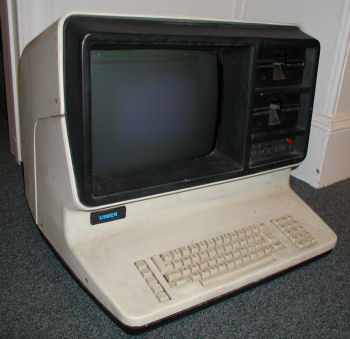
The Lanier Model 103 Word Processor / Computer
As you can see it's in pretty bad shape, but it may be at least partially restorable. I have not done much with it, other than open it up for a visual inspection. There's an 8080 processor on the disk drive control board.
More pictures... read moreS-100 board testing with Z-80 ICE
I just finished testing a Cromemco 64KZ RAM board. I did this by using Bob Grieb's Z80 ICE, which is made to be plugged into the Z80 slot of computer or controller card. Bob created his own "PIC-based circuit that could emulate a Z80 for displaying memory, writing to I/O ports, etc. as an aid to troubleshooting..." Bob's modern version is based on the Nicolet Paratronics Z80 emulator called the Z80 NICE. I am fortunate to have been given a beta version of this device to test. I inserted his Z80 ICE into a Jade CPU card, which is installed in my California Computer Systems 2200 Series S-100 computer. Using the ICE I was able to determine that the JADE controller was working correctly. Next I tested 2 64K RAM cards a read more12/20/2008 21:58 - Total messages in this thread: 3 Last Post: Somewhat similar memory failure. 12/23/2008
CBM 8088 co-processor update
I took the co-processor out of the dead unit it came from and installed into a working machine. Voila!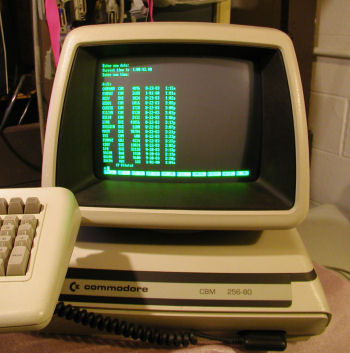
Commodore CBM 256-80 with 8088 co-processor MS DOS 1.25 directory on display.
read more 12/22/2008
CBM SuperPET Tips
The manuals supplied by Commodore are frustratingly incomplete and require a lot of head banging and experimenting to accomplish what should be simple tasks. The top of the klugey list is printing a program listing. Here are some useful tips and tricks including a few things that are not found in the original manuals. I still recommend that you try to find and read a copy of the SuperPET manuals (pamplets) too.The directory listing from a pair of SuperPET disks when viewed from 8032 BASIC. Note the failure of BASIC to correctly print the SEQ filenames created with the SuperPET in 6809 mode using Pascal (right/drive 0). The programming languages available to the SuperPET user are listed in drive 1/left drive. I am not sure what those SEQ files are, probably test programs.
SuperPET for Dummies
Last Post: SuperPET hardware links 12/21/2008
Lear Siegler ADM 3A
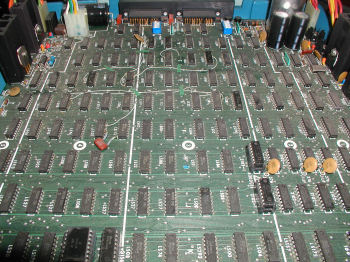
".. The ADM-3A transmits on pin 2, and receives on pin 3. Gnd is pin 7. .."
Terminal works. I assumed the pin configuration was similar to newer terminals and mistakenly thought that there was a TTL problem and I did not think to check the pins of the cable. Rookie mistake! Thanks Bob Grieb for setting me straight. Pictures ADM3A... read more
Last Post: Comments ... 12/19/2008
Teletype Model 15
Caption contest Avert your eyes before it's too late! "Ms. Amateur Radio 73 November 1976"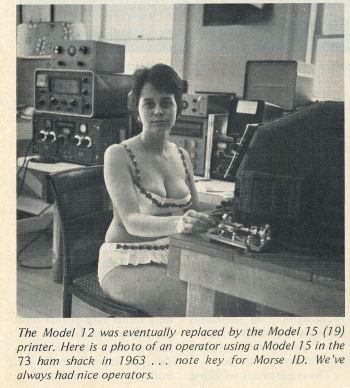
Click thumbnail to download larger image - suitable as a desktop background.
Actually, this photo was taken more than ten years earlier. Amongst photos of old teletypes in an article titled "Thirty Years of Ham RTTY", the photo above appears on page 112. What kind of bet did this lady loose? There is a story here. Perhaps you'd like to share your comments...... read more
IBM PC Convertible 5140 Laptop
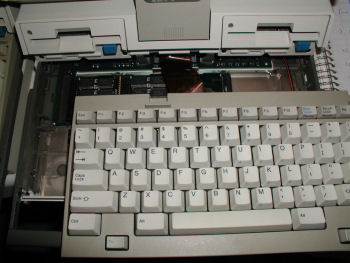
What make these IBM laptops tick, anyway? Recently I have been learning more about what you can and can't do with an IBM 5140 laptop. It's a non-PS/2 from 1986 that was popular until the PS/2 laptops started appearing a few years later. Surprisingly, a lot of the units I have come across still have working batteries!
I need more power supplies.
Pictures of 5140's... read more
12/07/2008 22:55 - Total messages in this thread: 2 Last Post: IBM 3101 Emulation IBM Series 1 12/08/2008
N* Horizon Motherboard Repair
Power leads on Northstar Horizon Motherboardsee page 31 of manual "Horizon Computer System Double Density" through page 37.
Power Leads
reset - grey (thinnner)
GND - black (thinnner)
-16V - yellow
GND - black from 11,000 uf cap.
+16V - orange
GND - 180,000 uf cap 1st wire
GND - 180,000 uf cap 2nd wire
+8v - red wire
+8v - other red wire
Drive A is not getting 5V (it's 1.3-2v)
Board is not sending the 5V to drive A
Had to determine whether 5v may also not be getting the controller cards - therefore the board is not bad, nor are the CPU cards.
Red wire coming from mother board +5v with P8 connector.
Need to replace the 7805 inside heatsink, 6030B, the front-most 7805. Last Post: N* Horizon Motherboard Repair 12/07/2008
More Blog Posts
